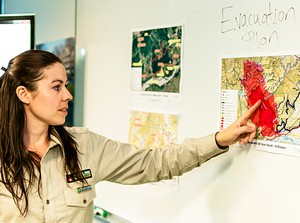Bright sparks help fight fires
 13 February 2015
13 February 2015
The recent Onamalutu forest fire in Marlborough was brought under control by firefighters, aircraft and one scientist. Veronica Clifford from Scion’s Rural Fire Research Group, is an expert at predicting fire behaviour as well as being a rural volunteer firefighter.
Veronica worked as a technical specialist in fire behaviour prediction for the National Incident Management Team (NIMT) managing the fire.
“Wildfires are destructive and frightening, but their behaviour is largely governed by known factors. By taking into account weather conditions, the lie of the land and vegetation, and the way they work together, we can go a long way to predicting the behaviour of most fires,” said Veronica.
“I used up-to-date weather forecasts for the area and other information to predict what the fire was likely to do over the next 12 hour period. Then I briefed management and the fire crews on how the fire was likely to behave at the twice daily shift changes.”
Richard McNamara, Principal Rural Fire Officer for the Marlborough Kaikoura Rural Fire Authority said having Veronica on the team meant fire crews received real time advice on a complex fire, with multiple fuel types on rough terrain.
“We used Veronica’s predictions to make decisions as to where to concentrate firefighters and aerial support, and when evacuations might be necessary.
“The wind changing direction was especially concerning. When we knew a southerly change was on its way, Veronica and I tracked its progress closely. The fire crews were working amongst tall timber at the time and there was the risk of weakened trees toppling when the wind changed.
“We predicted the change would arrive at 5.00 pm,” said Richard. “It arrived at 5.02. The fire crews were clear and safe.”
Veronica said this was her first multi-day wildfire. “Our research focuses on understanding how fire behaves in various conditions, and the factors that affect public and firefighter safety. Using the tools we have developed in the field and seeing their positive effects is very satisfying.
“My involvement with the Onamalutu fire is not over yet, I am doing further work to demonstrate what damage might have occurred without fire suppression, which will be used in an operational review of the fire.”
The fire prediction tools have been developed and refined by Scion’s fire research team working with MBIE, the New Zealand Fire Service Commission and the New Zealand rural fire sector. The software can be run on a computer or mobile phone.
Scion’s Rural Fire Research Group is based in Christchurch, and carries out research on fire in New Zealand's rural and forest landscapes. The research team concentrate on understanding how fires are likely to behave in different weather conditions, terrain and fuel types, and the factors affecting public and firefighter safety that are essential to fire management and prevention. See www.scionresearch.com/fire.
